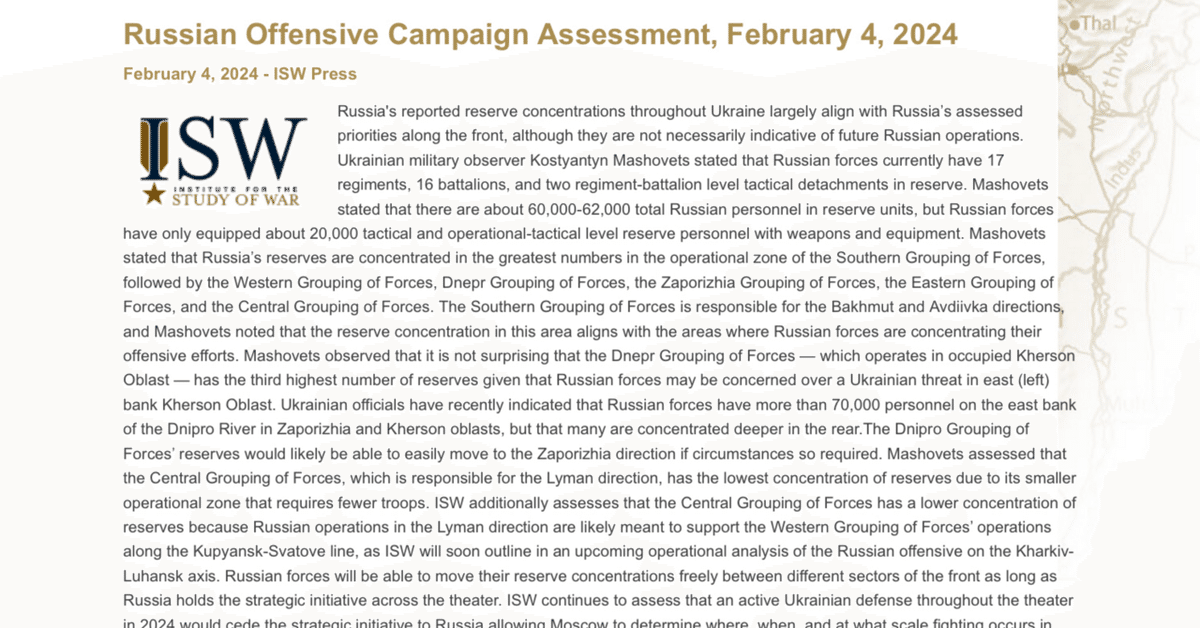
【抄訳】ISW ロシアによる攻勢戦役評価 1950 ET 04.02.2024 “ロシア軍予備戦力の集結状況と同軍の作戦上の優先順位”
本記事は、戦争研究所(ISW)の2024年2月4日付ウクライナ情勢評価報告の一部を抜粋引用したうえで、その箇所を日本語に翻訳したものである。
ロシア軍予備戦力の集結状況と同軍の作戦上の優先順位
報告書原文からの引用(英文)
Russia's reported reserve concentrations throughout Ukraine largely align with Russia’s assessed priorities along the front, although they are not necessarily indicative of future Russian operations. Ukrainian military observer Kostyantyn Mashovets stated that Russian forces currently have 17 regiments, 16 battalions, and two regiment-battalion level tactical detachments in reserve. Mashovets stated that there are about 60,000-62,000 total Russian personnel in reserve units, but Russian forces have only equipped about 20,000 tactical and operational-tactical level reserve personnel with weapons and equipment. Mashovets stated that Russia’s reserves are concentrated in the greatest numbers in the operational zone of the Southern Grouping of Forces, followed by the Western Grouping of Forces, Dnepr Grouping of Forces, the Zaporizhia Grouping of Forces, the Eastern Grouping of Forces, and the Central Grouping of Forces. The Southern Grouping of Forces is responsible for the Bakhmut and Avdiivka directions, and Mashovets noted that the reserve concentration in this area aligns with the areas where Russian forces are concentrating their offensive efforts. Mashovets observed that it is not surprising that the Dnepr Grouping of Forces — which operates in occupied Kherson Oblast — has the third highest number of reserves given that Russian forces may be concerned over a Ukrainian threat in east (left) bank Kherson Oblast. Ukrainian officials have recently indicated that Russian forces have more than 70,000 personnel on the east bank of the Dnipro River in Zaporizhia and Kherson oblasts, but that many are concentrated deeper in the rear. The Dnipro Grouping of Forces’ reserves would likely be able to easily move to the Zaporizhia direction if circumstances so required. Mashovets assessed that the Central Grouping of Forces, which is responsible for the Lyman direction, has the lowest concentration of reserves due to its smaller operational zone that requires fewer troops. ISW additionally assesses that the Central Grouping of Forces has a lower concentration of reserves because Russian operations in the Lyman direction are likely meant to support the Western Grouping of Forces’ operations along the Kupyansk-Svatove line, as ISW will soon outline in an upcoming operational analysis of the Russian offensive on the Kharkiv-Luhansk axis. Russian forces will be able to move their reserve concentrations freely between different sectors of the front as long as Russia holds the strategic initiative across the theater. ISW continues to assess that an active Ukrainian defense throughout the theater in 2024 would cede the strategic initiative to Russia allowing Moscow to determine where, when, and at what scale fighting occurs in Ukraine and to allocate Russian resources appropriately while forcing Ukraine to respond. Ukraine would be able to deny Russia this ability, however, if Ukraine were able to contest the initiative.
日本語訳
ウクライナ各所におけるロシア軍予備戦力の集結状況が報じられているが、その内容は推定されるロシア側の戦線上の優先順位と一致している。だが、この予備戦力集結状況が、今後のロシア軍作戦の方向性を、必ずしも示しているわけではない。
ウクライナ人軍事ウォッチャーのコスチャンティン・マショヴェツによると、ロシア軍は現在、予備戦力として、17個連隊、16個大隊、2個の連隊〜大隊規模分遣隊を有しているとのことだ。また、ロシア軍予備部隊の兵力は全体で約60,000〜62,000人であるが、ロシア軍が兵器等の各種装備を支給できているのは、戦術/作戦戦術規模の予備兵力約20,000人のみであると、マショヴェツは指摘した。さらに、マショヴェツによると、ロシア軍予備戦力が最も多く集結している地区は、[ロシア軍]南部部隊集団の作戦担当地域であり、以下多い順に、西部部隊集団、ドニエプル[ドニプロ]部隊集団、ザポロジェ[ザポリッジャ]部隊集団、東部部隊集団、中央部隊集団の各担当地域になるとのことだ。南部部隊集団はバフムート方面とアウジーウカ方面を担当している。そして、これらの地域での予備戦力集結は、それらの地域でロシア軍が攻勢努力を強めていることと符合していると、マショヴェツは述べている。ロシア占領下ヘルソン州で作戦遂行中のドニエプル部隊集団が、予備戦力の兵数で3番目に位置しているのは、ヘルソン州東岸(左岸)でウクライナ軍が及ぼす脅威にロシア軍が懸念している可能性を考えると驚くことではないと、マショヴェツは主張した。ウクライナ当局者が最近示した情報によると、ザポリッジャ・ヘルソン両州のドニプロ川東岸にロシア軍は70,000人を超える兵力を有しているが、その多くは前線後方のかなり奥に集められているとのことだ。また、ドニエプル部隊集団が有する予備戦力のザポリッジャ方面への移動は、そうする状況が生じた場合、容易に行うことができる可能性が高い。リマン方面を担当している中央部隊集団に関して、この部隊集団の作戦担当地域がほかと比べて狭く、多くの部隊を必要としないため、予備兵力の集結規模が最も小さいという分析をマショヴェツは示している。ISWはその評価分析に加えて、中央部隊集団の予備戦力の集結規模が小さいのは、リマン方面でのロシア側の作戦が、おそらくクプヤンシク〜スヴァトヴェ線沿いでの西部部隊集団の作戦を支援する意図であることもその理由であると判断している。なお、左記に関する概要説明を、近々に公開する予定のハルキウ〜ルハンシク作戦軸におけるロシア軍攻勢の作戦分析のなかで、ISWは示すつもりだ。ロシアが戦域全体で戦略的主導権を保持している限り、ロシア軍は今後、戦線上のさまざまな地区の間で、集結させた予備戦力を自由に動かすことができる。2024年に戦域の各所でウクライナがアクティブ・ディフェンスを行う場合、ロシアに戦略的主導権を譲り渡すことになり、その結果、ウクライナで戦闘を起こす場所・時期・規模を、モスクワが決定できるようになり、ウクライナが対応を強いられている間に、モスクワはリソースを適切に割り振れるようになると、ISWは分析しており、この分析評価は以前と変わっていない。だが、ウクライナが主導権争いを行うことができる場合は、ロシアが上述の能力を行使することを、ウクライナは拒絶することができるだろう。
この記事が気に入ったらサポートをしてみませんか?
